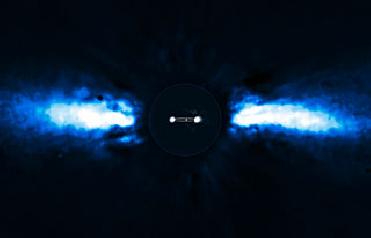
The above composite image shows the reflected light on the dust disc in the outer part. In the central part, the observations of the planet obtained in 2003 and autumn 2009 are shown. An ESO Photo
PARIS (BNS): An exoplanet revolving around its host star has caught the attention of astronomers who, for the first time, have directly followed the planet's movement from one side of the star to the other.
The planet, having a mass about nine times that of the Jupiter, is orbiting the star Beta Pictoris.
Astronomers, with the help of European Southern Observatory�s Very Large Telescope, have directly tracked the planet�s movement from one side of its host star to the other side.
The planet, called Beta Pictoris b, has the smallest orbit so far of all the directly imaged exoplanets. The planet's distance from its host star is similar to Saturn�s distance from the Sun. Astronomers believe that the planet may have formed the same way as the giant planets of our Solar System.
The star it is revolving around is only 12 million years old or less than three-thousandths of the age of the Sun, but is 75% more massive than the Sun. Located about 60 light-years away towards the constellation of Pictor (the Painter), the Beta Pictoris is one of the best-known examples of a star surrounded by a dusty debris disc which result from the collisions of large cosmic bodies like planetary embryos or asteroids.
The disc around Beta Pictoris extends up to about 1000 times the distance between the Earth and the Sun. Since the star is so young, the exoplanet�s existence around it proves that gas giant planets can form within discs in only a few million years, a short time in cosmic terms.
The immediate surroundings of Beta Pictoris were first studied in 2003 during which a faint source inside the disc was observed. In the subsequent images taken in 2008 and 2009, the object, to astronomers' surprise, had disappeared from the scene.
The most recent observations, taken during autumn 2009, revealed the object on the other side of the disc after a period of hiding either behind or in front of the star (in which case it is hidden in the glare of the star). This confirmed that the source indeed was an exoplanet and that it was orbiting its host star. It also provided insights into the size of its orbit around the star.
�Those were indirect, but tell-tale signs that strongly suggested the presence of a massive planet, and our new observations now definitively prove this,� said Anne-Marie Lagrange, the team leader of astronomers who studied the exoplanet.
�Because the star is so young, our results prove that giant planets can form in discs in time-spans as short as a few million years,� Lagrange said.
 Previous Article
Previous Article Next Article
Next Article













The Indian Air Force, in its flight trials evaluation report submitted before the Defence Ministry l..
view articleAn insight into the Medium Multi-Role Combat Aircraft competition...
view articleSky enthusiasts can now spot the International Space Station (ISS) commanded by Indian-American astr..
view article